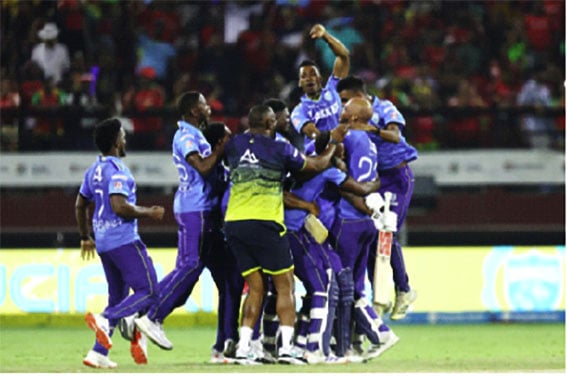By Andre E Baptiste
(Trinidad Guardian) The truth is, the less said on the 2024 version of the Caribbean Premier League (CPL) will best do this imitation of years gone, the justice it deserves.
There were so many areas of what turned into a retirement party for several players in the finals and elsewhere (led by, but not consigned to only 40-year-old victorious, former South African player Faf Du Plessis, victorious captain of the St Lucia Kings and 45-year-old, former South African player Imran Tahir, captain of the Guyana Amazon Warriors).
So let us start with many congratulations to the two finalists as they played the hands they were dealt and within the rules that were either imposed or adopted based on prevailing circumstances.
However, ultimately the Caribbean people lost because the doubt and questions over the authenticity and trustworthiness of this paradigm that was CPL 2024 must be investigated and persons must be called to account in a transparent way with consequences.
While I know that will not happen as many of these foreigners who run the CPL perceive the region as one that blows hot air and can easily be satisfied by a session of rum and more rim of different shades, toss in some flavoured seafood and even out nebulous media will come apart at the seam.
On radio recently, I was asked why our broadcasters were silent to many questions such as:
1) A player appealing a DRS review decision while in the dressing room.
2) Changing times of restart of a match hindered by human error not rain or bad weather.
Most of these persons whether from T&T or not have to earn a living and therefore will not be willing to sacrifice the riches of flavour but ultimately history will hunt them down later as they grow older and reflect on the errors of their ways.
But noteworthy while many call feel ashamed of the journalists in this country, I have to commend Rawle Toney of Guyana who stepped forward to say the truth, that the lights problems at Providence occurred on at least two occasions in August 2024 and both the management of the Providence Ground and the Government would have been involved in the debacles in August. The obvious retort would be in what form or fashion, did the Two Petes (Russell and Miller) have this information before the venue was utilised for matches.
The stain on the CPL is so severe in social media and around the world that I expect in the next few days we will have the usual suspects singing the blues about how “wonderful the tournament was” while collecting the blue colour of notes for their eye-catching work.
Cricket West Indies cannot escape their past as well, as they imposed the CPL ownership (still to be ascertained and confirmed) upon all six million people, once United by cricket but now instead divided by doubt and dastardly deeds. I would like to tell the British who run CPL that this is not the English Premier League, where opposing fans are separated in venues. In the region, we are accustomed to sitting together and heckling and bantering with each other, but the recent increasing incidents of fighting especially in Guyana are not good and unwanted. I have been asked by many to have the CPL answer certain questions but I sense there is some trepidation whether man-made or otherwise to run far and avoid.
Here are a few questions for the CPL communication team (if they still exist):
1. Economic impact
What is the estimated revenue generated from the tournament (ticket sales, sponsorship, broadcasting rights, merchandise)?
How did the local businesses (hotels, restaurants, transport services) benefit from the influx of fans?
What was the impact on employment during the tournament (temporary and permanent jobs)?
How did the tournament affect tourism in the host countries?
Were there any long-term investments in sports infrastructure or facilities as a result of hosting the tournament?
2. Social and cultural impact
How did the tournament influence the sense of national pride or unity?
How has the tournament inspired local youth to participate in sports or cricket?
Were there any initiatives during the tournament to promote gender equality or inclusivity in sports?
How did the tournament impact the perception of the country internationally, especially among visiting fans and media?
3. Environmental Impact
What measures were taken to minimise the environmental footprint of the tournament (eg, waste management, carbon offsetting)?
Were there any notable environmental initiatives tied to the event (eg, green stadiums, eco-friendly transportation)?
What was the level of environmental degradation (pollution, traffic congestion) during and after the tournament?
4. Sporting impact
How did the performance of the national cricket team during the tournament affect the popularity of the sport?
Has there been an increase in participation in cricket at the grassroots level as a result of the tournament?
Were there any new cricket talents discovered during the tournament?
5. Media and broadcasting impact
What was the viewership of the tournament domestically and internationally?
How did the tournament affect social media engagement and digital content creation around cricket?
Were there any innovations in broadcasting or media coverage that set new trends in sports presentation?
6. Political impact
Did the tournament influence any changes in national or local sports policies?
How was the tournament used as a diplomatic tool, especially if international/Regional teams/players participated?
Was there any government involvement in the Tournament?
7. Long-term legacy
What lasting improvements in infrastructure (stadiums, transportation, etc) are attributable to the tournament?
How has the tournament impacted future sports event planning or the possibility of hosting larger global events?
What lessons were learned in terms of managing large-scale sporting events?
So next we have 2025 but I wish to let the CPL know that the people of the region (majority) are not as backward and outdated in facts and intelligence as many believe so we will “Not Forget”.











